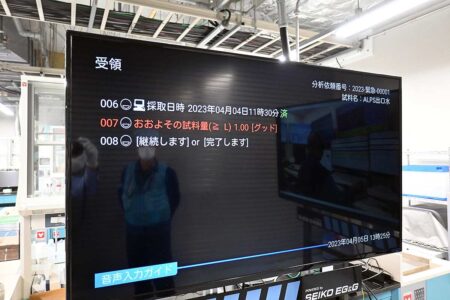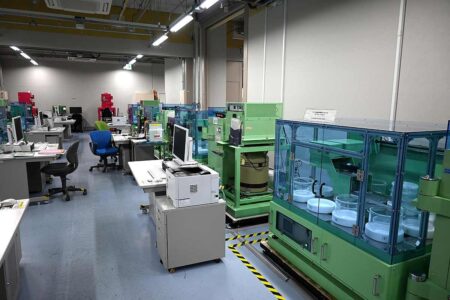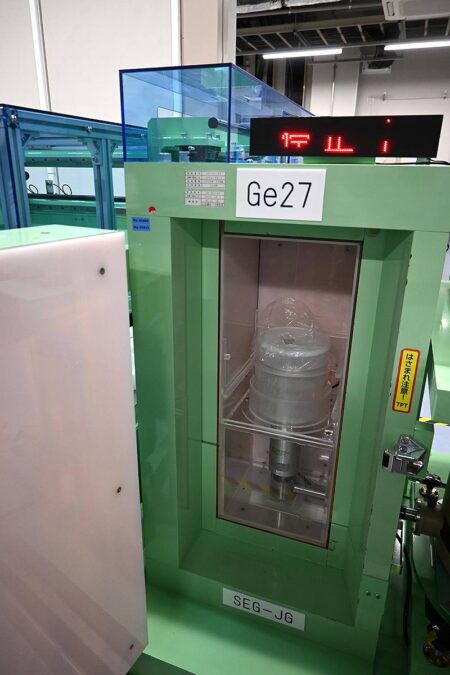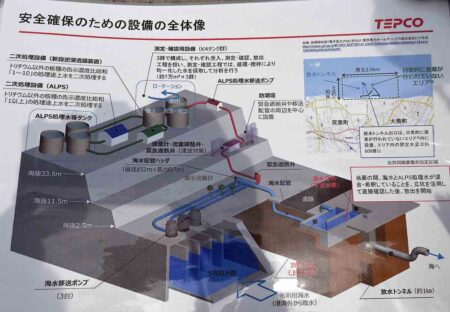Decommissioning Fukushima / TEPCO Tightens Monitoring Ahead of Treated Water Release

An analyst at TEPCO’s Fukushima No.1 nuclear power plant wears smart glasses as she prepares to measure tritium in ALPS treated water on April 5.
14:15 JST, May 3, 2023
When the cherry blossoms were in full bloom earlier than usual this year, I was again subjected to rigorous checks of my identification and personal belongings. And I wasn’t at an airport.
The security screening was taking place at the entrance to the Fukushima No. 1 nuclear power plant of Tokyo Electric Power Company Holdings, Inc. (TEPCO).
After being allowed to pass through the Entrance and Exit Control Building, I was led to the chemical analysis facility where radioactive materials are measured. It was in the basement down a flight of stairs leading from the control building.
I slipped on a new pair of socks over the ones I already had on, put on the rubber shoes provided, and went inside the facility. The place looked like a combination of several large rooms, each lined with a variety of equipment I had never seen before, giving it the appearance of a chemistry laboratory.
At the plant, about 90,000 samples of radioactive materials are measured and analyzed in a year. This is not only because the plant caused an unprecedented accident due to the March 2011 Great East Japan Earthquake and tsunami. It is also because TEPCO has expanded the number of monitoring points where seawater is analyzed in preparation for the discharge of treated water into the ocean, which is expected to begin as early as this summer.
The purpose of the strengthened monitoring is to confirm the safety of the water before and after the discharge, and to disseminate the results to the public.
So how exactly is TEPCO conducting the measurements and analysis?
To find out, I made this follow-up visit on April 5 after having toured the power plant site a few months earlier in January.
“To prevent mistakes, we have introduced a system of centralized management using QR codes,” explained Junichi Suzuki, the group manager in charge. “We manage all information from registration to results, including when and where samples were collected, which radioactive materials were measured, who analyzed them, and which equipment was used.”
Introduced in 2019, the calculation of concentrations is now also done by software instead of humans. He said that work efficiency has improved dramatically, and mistakes have been eliminated.
I was shown the treated water analysis site, where a female analyst was working while wearing goggle-like glasses.
“These are smart glasses,” Suzuki said. “They make it possible to see each step of the workflow.”
The analyst followed procedures projected inside the smart glasses. She held a container of treated water that had a QR code affixed to it, then read off the date and time of collection on the label. A camera attached to the smart glasses captured the QR code and the label. The video images were projected onto the computer of a person in charge in a separate office building, who could also be seen on a screen, and who then used a keyboard to input the date and time of collection.
When both the analyst’s voice and keyboard input match, the information is registered in the system and the analysis can begin.
Each time the analyst completed a task, she said, “Good.” The smart glasses then instructs the analyst on the next step.
-

The video image captured by the camera of the smart glasses is displayed on the monitor on the right.
-

An analyst checks the date of collection and other information on a container of treated water.
-

A person in charge, who is in an office in a separate building, is shown on a monitor and paired with an analyst to carry out the work.
-

The same workflow as projected on the smart glasses is displayed on a monitor.
-

An analyst proceeds with the work.
-

Junichi Suzuki, group manager, uses an information panel to explain the tritium measurement and analysis process.
-

The work in progress is shown in red.
-

An analyst carefully performs pre-processing work.
The radioactivity levels of samples vary, from high to low. At the chemical analysis facility, the staff analyze samples with low radioactivity levels, such as treated water, seawater from the surrounding area, and purified water from subdrainage. There are 31 analysts, and together they register an average of about 100 samples per day. Along with another analysis room on the premises, about 90,000 radioactive materials are analyzed annually at the Fukushima No. 1 nuclear power plant.
-

After pre-processing, the treated water is placed in a tritium measuring device.
-

The tritium concentration is measured with this device.
-

Various types of equipment are seen in the chemical analysis building.
-

Treated water that has been pre-processed for measurement is relayed to the room where the measuring device is located.
Moving deeper into the room, there were devices that measure tritium in the treated water and other radioactive materials that emit beta rays. There are 14 of these blue and white devices. Their number has increased as more analyses have been performed.
Behind them were 12 instruments for measuring gamma rays, such as from cesium-137, with analyses specimens placed behind 15-centimeter-thick lead doors.
-

A device to measure gamma rays such as that of cesium-137 has a door made of lead that is about 15 centimeters thick.
-

A container that will be placed in the gamma-ray measuring device.
-

The vinyl bag will be removed before the actual measurement is conducted in the gamma-ray measuring device.
-

A device that measures iron-55, which emits only very low-energy gamma rays. Because of its weight, the device is placed on a seismic isolation platform.
Further in, there were also two sturdy pink devices. These were recently introduced to measure iron-55 (Fe-55), a radioactive isotope of iron, which has been added as an item for detection among the 69 nuclides of radioactive materials measured before each discharge of treated water.
“Iron-55 is a radioactive material that emits only very low-energy gamma rays,” Suzuki said, “so this is the device for measuring it.”
Expansion of seawater monitoring
In the sea area around the nuclear power plant, the national government, Fukushima Prefecture and TEPCO are among those who have been continuously measuring radioactive materials in accordance with the government’s comprehensive monitoring plan since 2011, the year of the accident.
Based on the plan revised in March this year and with a view toward discharging treated water into the ocean later this year, TEPCO has increased the number and frequency of monitoring points and lowered the detection limit for tritium, which is most abundant in the treated water. The number of monitoring points has increased by 85 to about 260, and analysis is being conducted sequentially.
The tritium detection limit, which was previously 0.4 becquerels per liter, has been lowered to 0.1 becquerels in accordance with the standards set by the Environment Ministry and other organizations. The reason for this is that some have argued that it is confusing if standards vary. It is now possible to measure lower levels, but the analysis results for the 0.1 level require the electrolytic enrichment process, meaning it takes about two weeks longer than results for the 0.4 becquerel level, obtainable in about three days.
Some residents have said that they want immediate results confirming that there is no problem. For this reason, a TEPCO Holdings official said, “While conducting measurements with low detection limits, we will also conduct measurements with higher limits and release these results in the form of prompt preliminary reports at the same time.”
The results of the analyses are available on TEPCO’s treated water portal site, where data from the central government and the prefecture can be viewed together.
Released from plants worldwide
The reason for measuring the concentration of tritium in the treated water is that while it is possible to remove most radioactive materials, such as cesium and strontium, from contaminated water that has come in contact with nuclear fuel using the advanced liquid processing system (ALPS), it is not possible to remove tritium, which is hydrogen with three particles in its nucleus rather than the usual one.
TEPCO will dilute the treated water with a large amount of seawater to reduce the concentration to less than 1,500 becquerels per liter before discharging it. The treated water is then discharged at a point 1 kilometer offshore, where it will be quickly dispersed by the tidal currents, and the concentration is expected to further drop dramatically.
Tritium is a radioactive isotope of hydrogen that exists in nature and is found in trace amounts in rainwater and mineral water. In Japan, daily ingestion of tritium is about 1 becquerel, and it is present in our bodies. Tritium produced through nuclear power plant operations and reprocessing facilities is released all over the world and does not come only from nuclear power plants that have had accidents.
According to the Economy, Trade, and Industry Ministry, in a one-year span, tritium released at the Darlington nuclear generating station in Canada totaled 220 trillion becquerels in 2018, and in 2019 at the Kori nuclear power plant in South Korea it was 91 trillion becquerels, while it was 87 trillion becquerels at the Hongyanhe nuclear power plant in China. In contrast, the ALPS-treated water to be released in one year at the Fukushima No. 1 nuclear power plant would contain less than 22 trillion becquerels of tritium, which would be the standard amount released as in 2010, before the accident.
Japan’s regulatory concentration limit for tritium in water is 60,000 becquerels per liter, and the World Health Organization’s drinking water standard guideline is 10,000 becquerels per liter. TEPCO’s 1,500 becquerels per liter is 40 times more stringent than the national standard.
Construction continues
-

Cherry blossoms in bloom on the premises of the Fukushima No. 1 nuclear power plant. Tanks of treated water can be seen in the background.
-

Cherry blossoms bloom on the premises.
-

Cherry blossoms appear at full bloom on “Sakura-dori” (cherry blossom street).
Outside the control building, the cherry blossoms were in full bloom along a road on the premises called “Sakura-dori” (cherry blossom street). This area is located on high ground about 35 meters above sea level, so it was not damaged by the tsunami. Although the cherry trees were exposed to radiation from the accident, they have reportedly been blooming every year without any issues.
-

Pumped seawater will flow through the three blue pipes and mix with treated water at the large header pipe, also blue, in the background.
-

ALPS treated water will flow through this transfer pipe from tanks on higher ground.
-

A TEPCO illustration shows the flow of treated water.
-

Walls are being constructed for the upstream tank.
-

The upstream water tank is seen under construction on Jan. 26.
It was just over two months since I had visited the construction site for the discharge infrastructure along the sea on the north side of the premises. The construction work was progressing steadily. Three thick pipes through which large amounts of seawater are carried extend from seawater pumps. At the end of the pipes was a huge header pipe through which the treated water, which flows through a transfer pipe from higher ground, will be mixed with the seawater.
After that, the diluted treated water enters the upstream water tank, overflows into the downstream water tank next to it, and goes through the tunnel at the bottom to the discharge outlet 1 kilometer offshore. The upstream water tank, whose inner structure was visible two months ago, had been walled off, and the shield machine excavating the tunnel was back in operation. The top of the platform directly above the water discharge outlet, which was set up at a depth of about 12 meters, will be removed shortly.
TEPCO will release the water after final confirmation that the tritium concentration in the treated water, diluted with seawater, is below 1,500 becquerels per liter at the location where the upstream and downstream water tanks are located.
“We will dilute the water with a large amount of seawater before releasing it, so the level at the time of release will be much lower than 1,500 becquerels per liter,” said one of the TEPCO officials who showed me around the site.
-

Tanks used immediately after the 2011 accident to store contaminated water. These tanks were originally used for water storage for parks and such places and were urgently acquired from various locations in Japan.
-

The northernmost shore of the site. Seawater to dilute the treated water is pumped up from here.
-

Panels that will make up the undersea tunnel.
In the pre-discharge phase, 69 nuclides, more than before, will be measured. Just before discharging the water, the tritium level will be measured. The measurement of radioactive materials in seawater and in fish after the discharge has also been enhanced.
Nevertheless, once the release of the treated water begins, there is concern that reputational damage will once again occur, both domestically and internationally. Even if safety can be proven, it will take time to reassure the public.
To curb the reputational damage, both TEPCO and the national government must disclose data widely and provide detailed explanations while making efforts to foster peace of mind and trust.
"JN Specialities" POPULAR ARTICLE
-

The Japan News / Weekly Edition (12/12-12/18)
-

Noodle Dining Shunsai / Rich Oyster Ramen to Savor at Odasaga; Experienced 68-year-old Owner Creates Numerous Ramen Varieties
-

The Japan News / Weekly Edition (12/5-12/11)
-

People Keep Loved Ones’ Ashes Close in Special Jewelry, Small Urns as Unique Way to Memorialize Them
-

The Japan News / Weekly Edition (12/19-12/25)
JN ACCESS RANKING
-

Tokyo Economic Security Forum to Hold Inaugural Meeting Amid Tense Global Environment
-

Keidanren Chairman Yoshinobu Tsutsui Visits Kashiwazaki-Kariwa Nuclear Power Plant; Inspects New Emergency Safety System
-

Imports of Rare Earths from China Facing Delays, May Be Caused by Deterioration of Japan-China Relations
-

University of Tokyo Professor Discusses Japanese Economic Security in Interview Ahead of Forum
-

Japan Pulls out of Vietnam Nuclear Project, Complicating Hanoi’s Power Plans





























